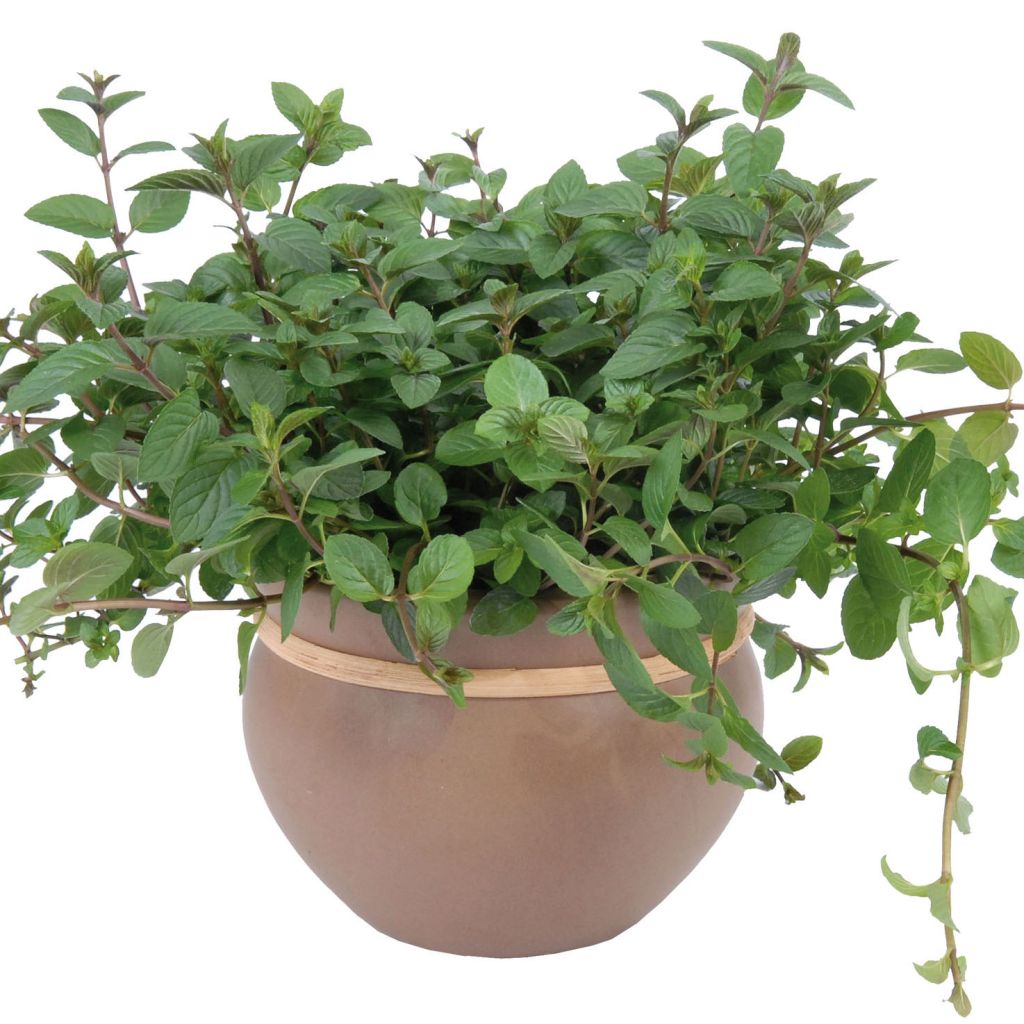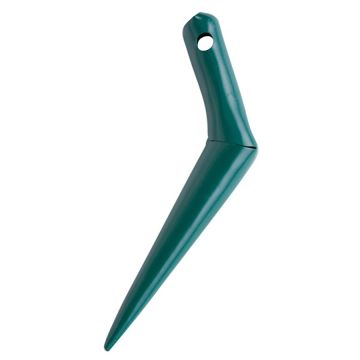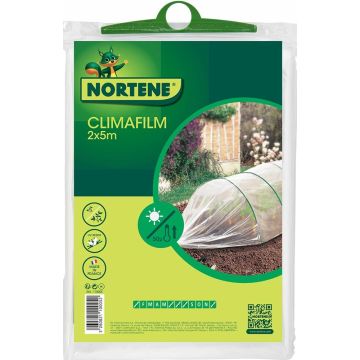

Menthe chocolat BIO en plants - Mentha chocolat
Mentha chocolat
Mentha chocolat
Chocolate Mint
Plants were small upon receipt but quickly adapted well and did not suffer from transportation. Packaging was of good quality and did not damage the plants upon unpacking.
Célestine, 12/06/2022
This item cannot be shipped to the selected country
Delivery charge from €5.90
More information
Schedule delivery date,
and select date in basket
This plant carries a 6 months recovery warranty
More information
We guarantee the quality of our plants for a full growing cycle, and will replace at our expense any plant that fails to recover under normal climatic and planting conditions.
From €5.90 for pickup delivery and €6.90 for home delivery
Express home delivery from €8.90.

Description
Chocolate Mint is a variety of peppermint whose leaves emit a subtle chocolate fragrance. This hardy, perennial herbaceous plant can be grown in the ground or in a pot. It will reach a height of 40 to 60 cm (16 to 24in). Its leaves are delicious in infusions, teas, or hot chocolate. They also flavor desserts. The plug plants of this variety are produced using organic methods. They can be planted in spring (from April to June) for a harvest from March to October.
Mint is an aromatic bushy plant with highly fragrant foliage. It belongs to the Lamiaceae family, like lemon balm. It is best to plant it in a semi-shaded location, although Mint can thrive almost anywhere. It is a perennial plant that will be cultivated for two or three years as beyond that, it tends to become less productive. Choose carefully where you want to plant it: Mint spreads quickly thanks to its trailing roots. You can also grow it in a pot, which allows you to control its spread. It is ideal to install in the vegetable garden as Mint is known to repel unwanted insects from the garden, such as aphids and ants, as well as some rodents. As for leaf harvesting, it can be done throughout the year, mainly from March to October.
There are many varieties of mint, the most well-known being spearmint, peppermint, pennyroyal, and lemon mint. Depending on the variety, the leaves will offer you a whole range of flavors. In cooking, use them from appetizers to desserts, to flavor salads and raw vegetables, summer grills, yogurt-based sauces, or fruits. The leaves are also delicious in infusions, teas, or hot chocolate.
Harvest: Harvest the leaves as needed. Choose the largest leaves and cut the entire stem to promote regrowth. Preferably harvest in the morning to enjoy the mint's aromatic qualities to the fullest. If you want to dry the leaves, pick the stems before flowering.
Storage: Ideally, consume the freshly cut leaves. If you don't use the fresh leaves, dry the stems and store the leaves in a tightly closed jar, away from light.
Gardener's tip: If you want to plant mint in the vegetable garden while limiting its spread, plant it in a pot and bury the pot in the middle of your garden! Choose a large enough pot and divide the clumps regularly, in autumn or spring.
Report an error about the product description
Harvest
Plant habit
Foliage
Planting and care
Planting is done in spring (from April to June) or at the end of summer (August to September). Choose a partially shady location if possible, although Mint can grow almost anywhere.
To start with, let the plug plants grow by transplanting them into trays or buckets with a diameter of 8 to 13 cm (3 to 5in) filled with compost. Place them in a warm and bright spot. Water regularly.
In open ground: Mint likes rich, fertile and moist soil. If your soil is poor, add well-rotted compost a few months before planting by loosening the soil to a depth of 5 cm (2in).
For planting in open ground, space the plants 40 cm (16in) apart in all directions. Soak the root ball in water for a few moments before planting. Dig a hole, place the root ball and cover with fine soil. Firmly press down and water to keep the soil moist. Water moderately during cultivation, especially in case of high temperatures.
In pots: Place a layer of gravel at the bottom of the pot to improve drainage. Fill it with compost, carefully place the plug plant and cover with soil. Firmly press down and water to keep the soil moist. Water regularly during cultivation, approximately once a week (or more during dry periods). Repot every year.
At the end of autumn, cut the stems to 10 cm (4in) above ground level to promote new growth.
Mint can multiply by dividing clumps in spring or by propagation by cuttings.
Cultivation
Care
Intended location
-
, onOrder confirmed
Reply from on Promesse de fleurs
Haven't found what you were looking for?
Hardiness is the lowest winter temperature a plant can endure without suffering serious damage or even dying. However, hardiness is affected by location (a sheltered area, such as a patio), protection (winter cover) and soil type (hardiness is improved by well-drained soil).

Photo Sharing Terms & Conditions
In order to encourage gardeners to interact and share their experiences, Promesse de fleurs offers various media enabling content to be uploaded onto its Site - in particular via the ‘Photo sharing’ module.
The User agrees to refrain from:
- Posting any content that is illegal, prejudicial, insulting, racist, inciteful to hatred, revisionist, contrary to public decency, that infringes on privacy or on the privacy rights of third parties, in particular the publicity rights of persons and goods, intellectual property rights, or the right to privacy.
- Submitting content on behalf of a third party;
- Impersonate the identity of a third party and/or publish any personal information about a third party;
In general, the User undertakes to refrain from any unethical behaviour.
All Content (in particular text, comments, files, images, photos, videos, creative works, etc.), which may be subject to property or intellectual property rights, image or other private rights, shall remain the property of the User, subject to the limited rights granted by the terms of the licence granted by Promesse de fleurs as stated below. Users are at liberty to publish or not to publish such Content on the Site, notably via the ‘Photo Sharing’ facility, and accept that this Content shall be made public and freely accessible, notably on the Internet.
Users further acknowledge, undertake to have ,and guarantee that they hold all necessary rights and permissions to publish such material on the Site, in particular with regard to the legislation in force pertaining to any privacy, property, intellectual property, image, or contractual rights, or rights of any other nature. By publishing such Content on the Site, Users acknowledge accepting full liability as publishers of the Content within the meaning of the law, and grant Promesse de fleurs, free of charge, an inclusive, worldwide licence for the said Content for the entire duration of its publication, including all reproduction, representation, up/downloading, displaying, performing, transmission, and storage rights.
Users also grant permission for their name to be linked to the Content and accept that this link may not always be made available.
By engaging in posting material, Users consent to their Content becoming automatically accessible on the Internet, in particular on other sites and/or blogs and/or web pages of the Promesse de fleurs site, including in particular social pages and the Promesse de fleurs catalogue.
Users may secure the removal of entrusted content free of charge by issuing a simple request via our contact form.
The flowering period indicated on our website applies to countries and regions located in USDA zone 8 (France, the United Kingdom, Ireland, the Netherlands, etc.)
It will vary according to where you live:
- In zones 9 to 10 (Italy, Spain, Greece, etc.), flowering will occur about 2 to 4 weeks earlier.
- In zones 6 to 7 (Germany, Poland, Slovenia, and lower mountainous regions), flowering will be delayed by 2 to 3 weeks.
- In zone 5 (Central Europe, Scandinavia), blooming will be delayed by 3 to 5 weeks.
In temperate climates, pruning of spring-flowering shrubs (forsythia, spireas, etc.) should be done just after flowering.
Pruning of summer-flowering shrubs (Indian Lilac, Perovskia, etc.) can be done in winter or spring.
In cold regions as well as with frost-sensitive plants, avoid pruning too early when severe frosts may still occur.
The planting period indicated on our website applies to countries and regions located in USDA zone 8 (France, United Kingdom, Ireland, Netherlands).
It will vary according to where you live:
- In Mediterranean zones (Marseille, Madrid, Milan, etc.), autumn and winter are the best planting periods.
- In continental zones (Strasbourg, Munich, Vienna, etc.), delay planting by 2 to 3 weeks in spring and bring it forward by 2 to 4 weeks in autumn.
- In mountainous regions (the Alps, Pyrenees, Carpathians, etc.), it is best to plant in late spring (May-June) or late summer (August-September).
The harvesting period indicated on our website applies to countries and regions in USDA zone 8 (France, England, Ireland, the Netherlands).
In colder areas (Scandinavia, Poland, Austria...) fruit and vegetable harvests are likely to be delayed by 3-4 weeks.
In warmer areas (Italy, Spain, Greece, etc.), harvesting will probably take place earlier, depending on weather conditions.
The sowing periods indicated on our website apply to countries and regions within USDA Zone 8 (France, UK, Ireland, Netherlands).
In colder areas (Scandinavia, Poland, Austria...), delay any outdoor sowing by 3-4 weeks, or sow under glass.
In warmer climes (Italy, Spain, Greece, etc.), bring outdoor sowing forward by a few weeks.


































